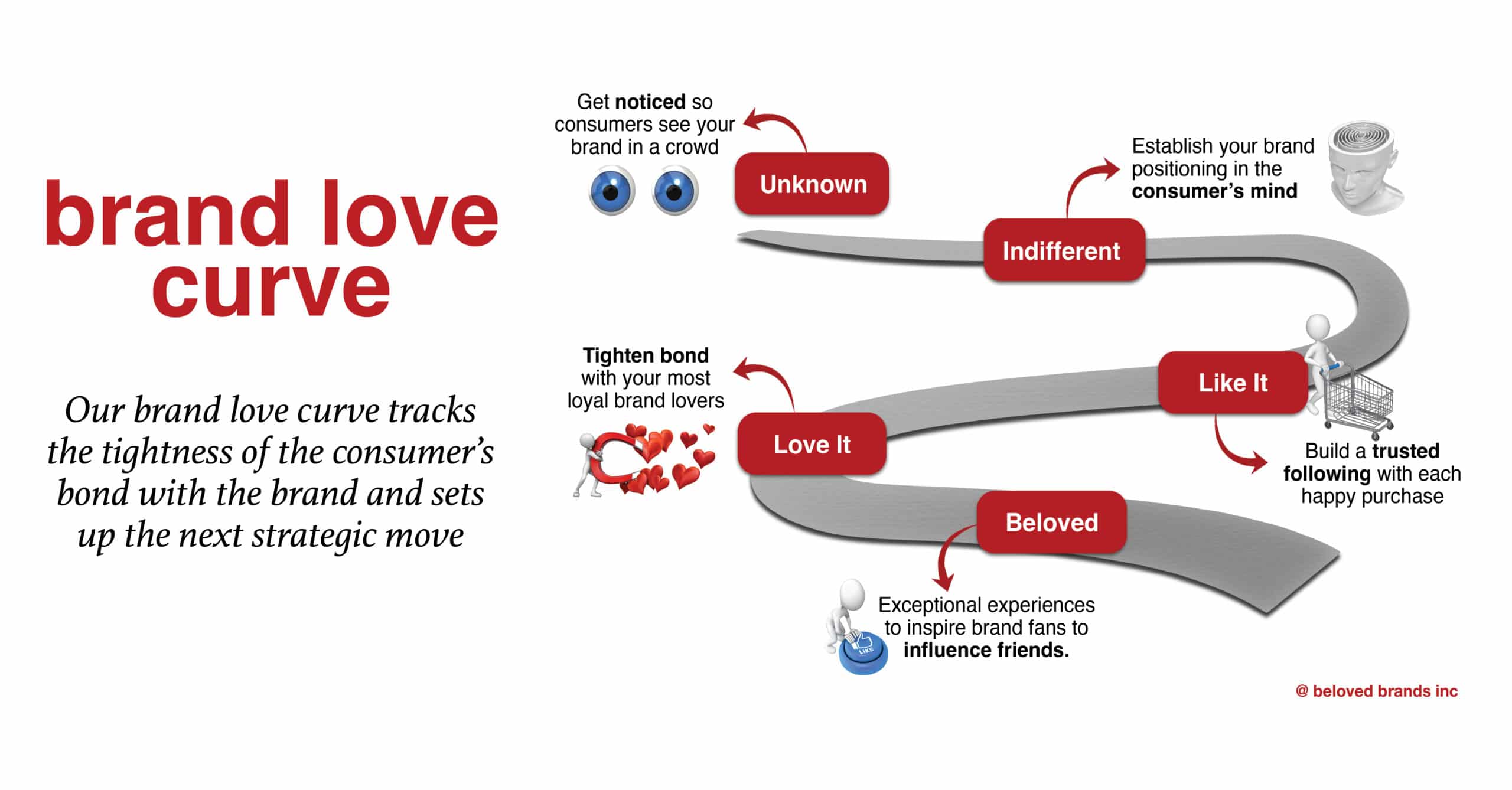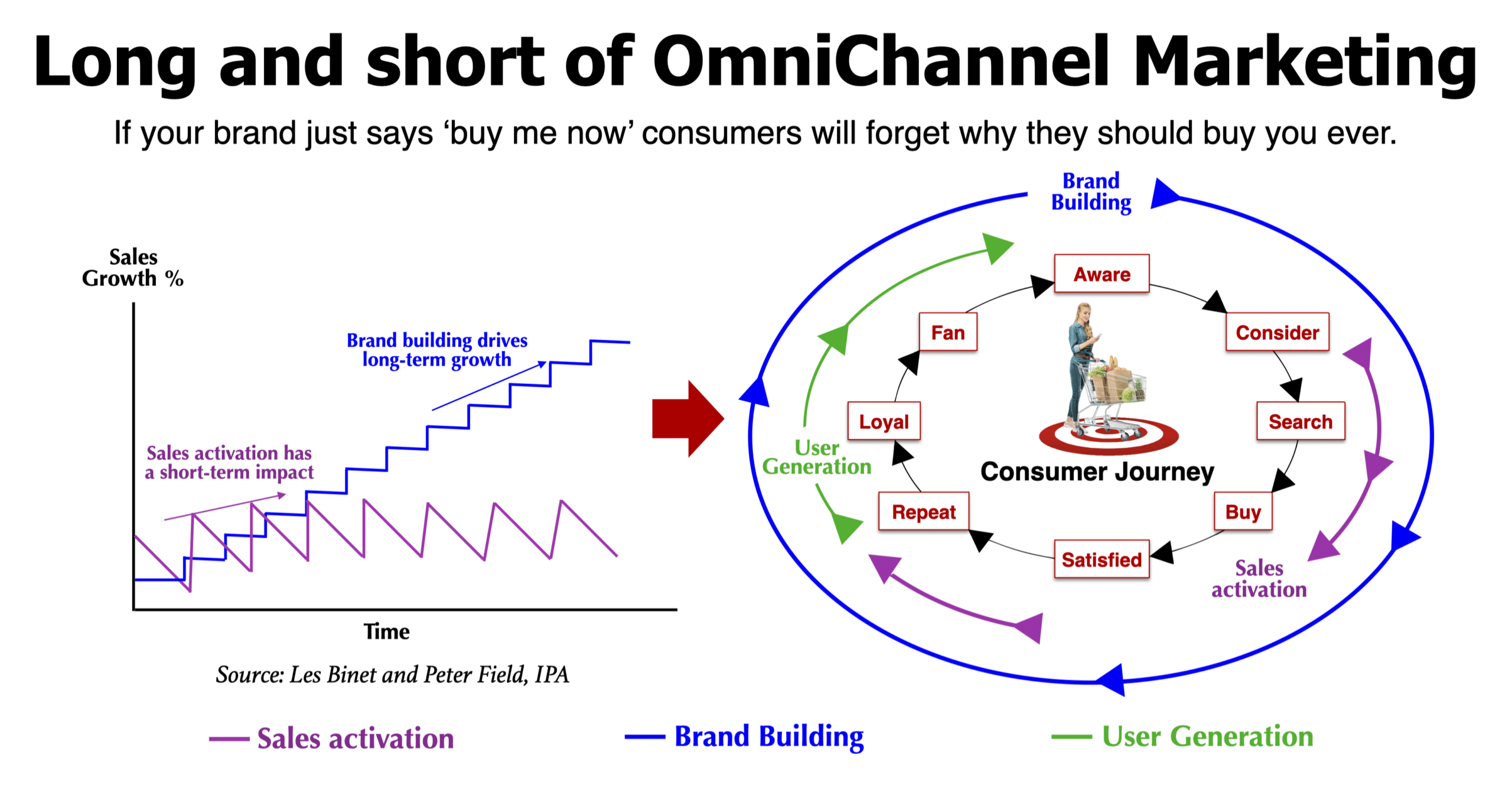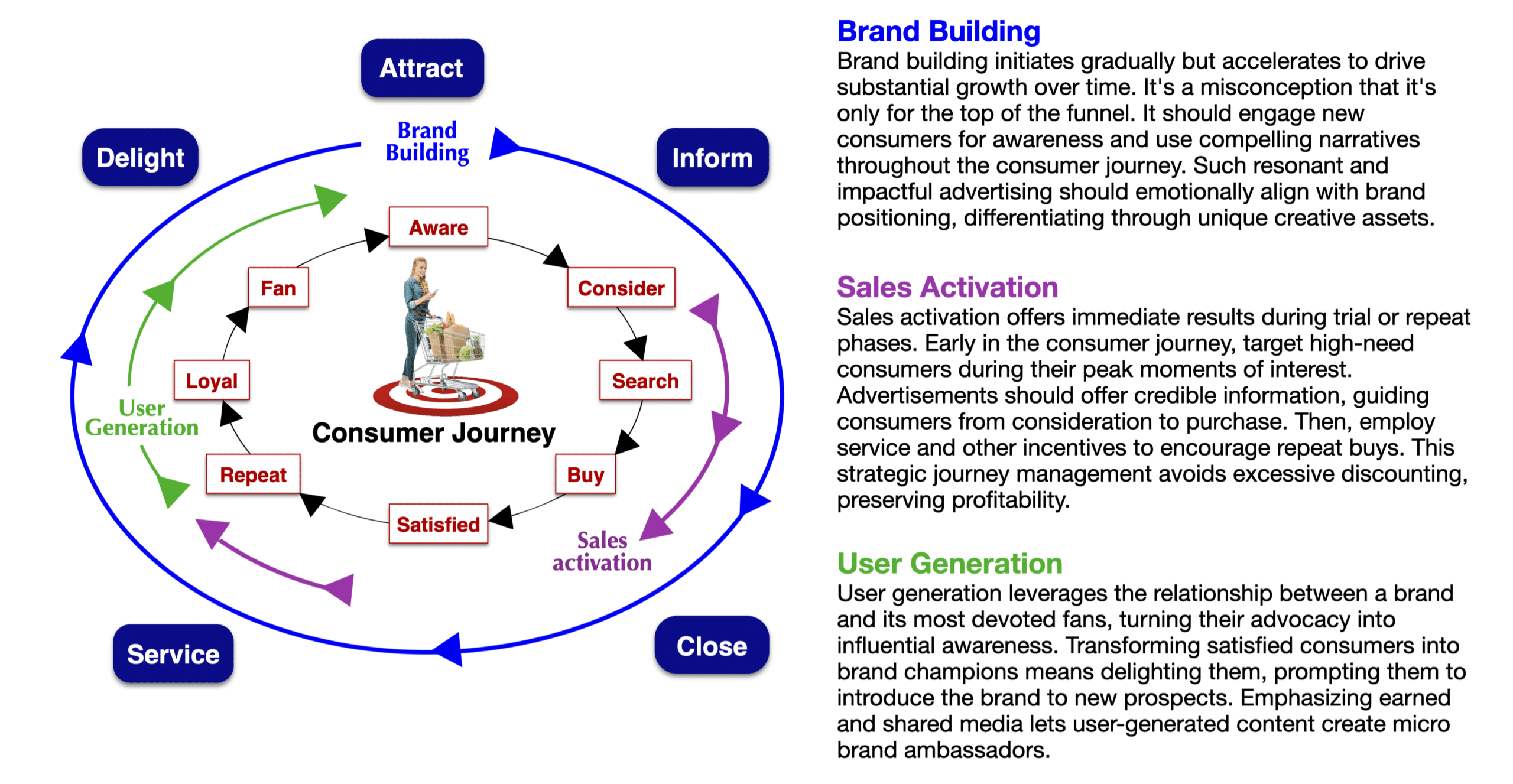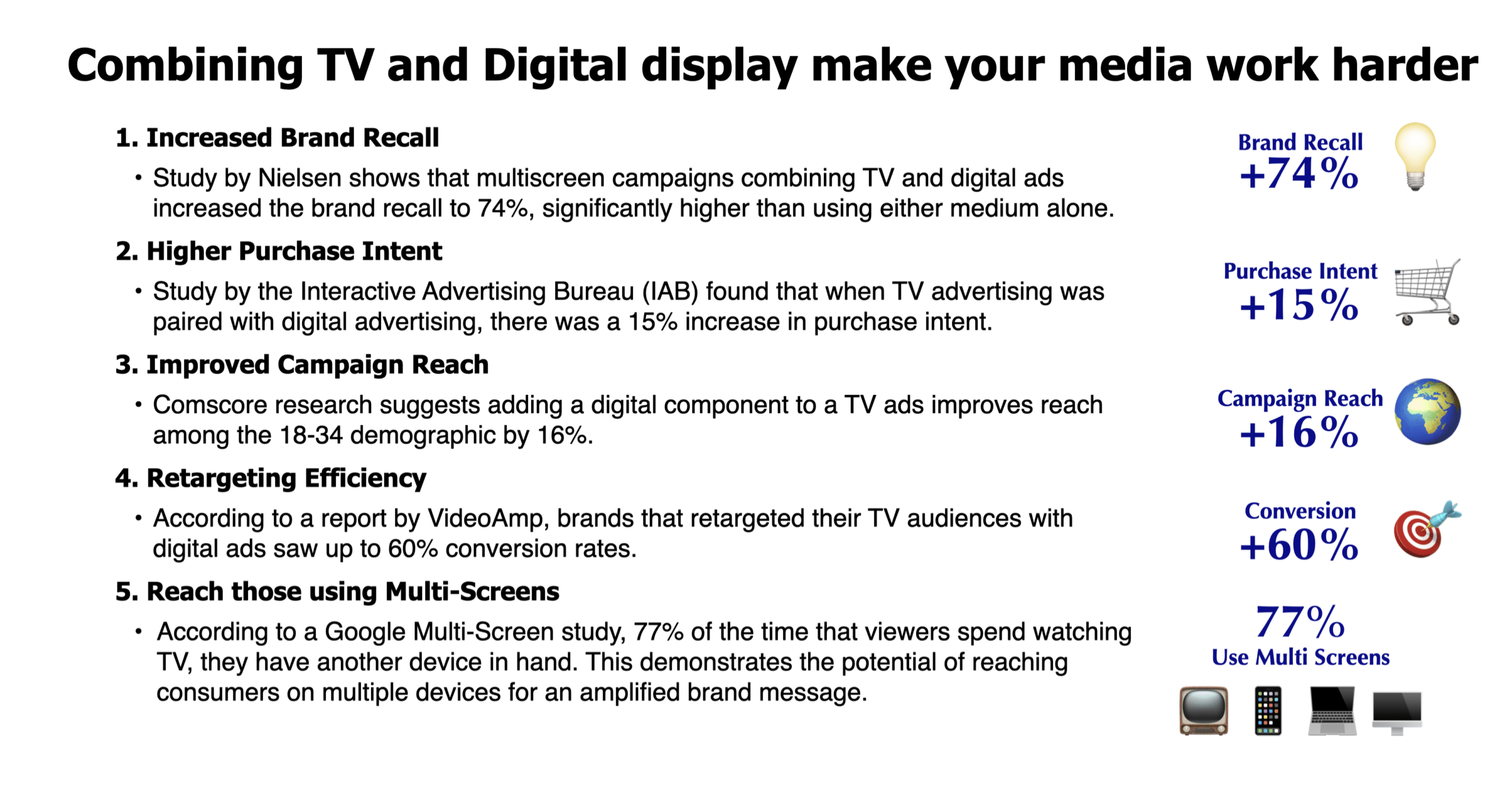In today’s dynamic digital age, understanding the consumer journey is paramount to brand success. OmniChannel Marketing offers a seamless strategy that aligns diverse channels, ensuring consumers receive a consistent and unified brand experience at every touchpoint. This article delves deep into the “brand love curve,” highlighting the consumer’s transformative journey – from indifference to becoming a beloved brand. We are seeing a big jump from multi-channel to OmniChannel Media management.
With a perfect balance between long-term brand building and short-term sales activation, brands can craft a symphonic narrative, effectively nudging consumers through awareness, consideration, and purchase.
As we shift from traditional multi-media approaches to a more integrated OmniChannel strategy, marketers must recognize how diverse media elements, be they paid, earned, owned, or shared, contribute to guiding consumers fluidly through their purchasing journey.
By tailoring content and engagement strategies at every stage, brands can create meaningful, lasting relationships with their audience, ensuring a purchase and a brand advocate for life.
If you are in marketing or brand management, dive in to explore the intricate dance of brand-building, sales activation, and the art of cultivating brand love in an OmniChannel world.
To illustrate, click on the OmniChannel Marketing diagram to zoom in and see details.
What is OmniChannel?
For years, our approach to multi-media was primarily focused on combining a lead medium with several supplementary options such as TV, radio, and out-of-home. But as the landscape evolves, brands are pivoting to a more holistic OmniChannel Media strategy. It’s essential to grasp how diverse media elements integrate, guiding consumers seamlessly through their journey.
OmniChannel Definition
The OmniChannel Marketing approach is an evolution of the multi-channel concept where all channels are integrated, providing a unified and seamless customer experience regardless of how, where, or when a customer chooses to interact with the brand. It matches up with the consumer journey. This means that a customer might start their shopping experience online, continue on a mobile app, and complete their purchase in a physical store, all while having a consistent and connected experience.
Key Features:
- Multiple, integrated channels of communication or sales.
- Seamless, unified customer experience across all channels.
- Consistency in branding, messaging, and services.
- Customer data is integrated and shared across channels to personalize experiences and ensure continuity.
Multi-Channel Definition
The multi-channel approach involves interacting with customers through multiple channels but these channels operate in silos, meaning they don’t necessarily integrate or communicate seamlessly with one another. For example, a business might have a physical store, a website, and a mobile app, and while customers can use any of these to make a purchase, the experiences and promotions across these channels might be distinct from one another.
Key Features:
- Multiple, distinct channels of communication or sales.
- Channels operate independently.
- Different customer experiences across channels.
- Customer data might not be shared or integrated across channels.
Consumer Strategy
Our brand love curve steers your consumer strategy
To replicate how brand building matches up with the building of a relationship, I created the brand love curve, which outlines how consumers move through five stages: unknown, indifferent, like it, love it, and onto the beloved brand status. Explore more on our consumer strategy, click this link: consumer strategy.
To illustrate, click on the OmniChannel Marketing diagram to zoom in and see details.
Five stages of the brand love curve.
Unknown brand
For new brands, they were completely “unknown” to consumers. Unless there were genuinely compelling messages, consumers would walk past without even looking. To achieve some success, the priority for these brands is to get noticed within the clutter of the market.
Indifferent stage
At the “indifferent” stage, consumers feel O.K. about the brand, similar to how they usually feel about commodities, like fruit and vegetables. These brands satisfy the consumer’s basic needs. Consumers will only buy the brand when it is on sale, but switch back to their other brand choice when it is not. Make your brand more than just a commodity. Brands need to be better, different, or cheaper. Otherwise, they will not be around for long, and you waste your investment.
Like it stage
Brands that reach the “like it” stage experience the first sign of business success. Their consumers see the brand as a logical, functional, and smart choice. However, the lack of any emotional connection leaves the purchase up to chance. Consumers will still switch brands randomly. Brands at the like it stage stress the product performance so much they forget to trigger any emotions.
Love it stage
Brands at the “love it” stage start to see more emotionally engaged consumers. The rule of love you must follow: Consumers must love the brand before you can tell consumers you love them. Consumers see the brand as a favorite choice, usually connected to a favorite part of their day. They are loyal and build the brand into a routine. These brands must also find a way to demonstrate their love toward consumers and continue to tighten the bond with their most loyal brand lovers.
Beloved brand
The “beloved brand” stage is where the brand becomes iconic, with a core base of brand lovers who cherish and defend the brand. These consumers see the brand as a personal choice, a badge they proudly hold in their hand or wear on their feet. At the beloved stage, the brands must create magical experiences that inspire brand lovers to share with their friends.
OmniChannel Marketing
How to move consumers along their journey.
To drive awareness, you need to stand out and be seen in a crowd. Invest in mass media to gain entry into the consumer’s mind using TV, digital, viral video, out of home, or magazine. Where it makes sense, sponsorships, and experiential events can increase the consumer’s familiarity with the brand.
To move consumers to the consideration stage, use influencers to teach those seeking to learn more. Use public relations to make the brand part of the news, whether through traditional, social, or blogger channels. Engage the online user review sites like Yelp, Trip Advisor, or review sites.
Pushing consumers to learn more.
For more complex or higher risk purchase decisions, consumers will rely on search for almost everything, even if to confirm what makes sense. Marketers can use search sites, such as Google, expert review sites, and online content, or long copy print media. The brand website comes into play and should include the right information to close off gaps or doubts, then move consumers towards the purchase decision.
OmniChannel media options to help trigger purchase, include point-of-sale advertising, with in-store signage, displays, and sales materials to prompt consumers at the purchase moment. Remarketing is a great tool to push consumers who might feel stuck at the consideration stage to reconsider and buy.
Building the relationship after the purchase.
After the purchase, turn usage into a ritual among your most loyal users. Cultivate a collection of brand fans, using VIP programs and experiential events with exclusive deals — layer in emotional advertising to tighten the bond. Once you have a strong base, you can mobilize your brand lovers, by intentionally creating shareable experiences, which will trigger brand lovers to share with their network through social media. With the new social media tools, the smartest brands are getting their most engaged consumers to drive awareness.
Marketers need to use the OmniChannel media approach to move consumers at every stage.
The long and the short of building a brand.
The long and short of building your brand through media strikes a balance between long-term brand building and short-term sales activation. There is a lot of proof in the marketing world that half your marketing efforts should focus on brand building and the other half on transactions. We are seeing too many brands go for the short-term sale, without establishing the brand.
To illustrate, click on the OmniChannel Media diagram to zoom in and see details.
How marketers need to work the long and short work together to build your brand.
I like to use brand-building anthemic advertising to establish the brand positioning, to create an emotional connections with your target audience, to strengthen brand identity, and foster consumer loyalty.
Brand-building establishes a sustainable competitive advantage and brand love, which translates to increased sales growth, market share, and profitability over time.
Short-term transactional advertising pushes for immediate results, such as boosting sales, increasing website traffic, or generating leads. These campaigns often leverage desires and impulses, promotions, discounts, or limited-time offers to create a sense of urgency and drive quick consumer actions.
While short-term advertising can yield immediate returns, over-reliance on this approach can harm brand equity and long-term growth. If all you do is say “buy me now” consumers will not know why they should ever buy you.
Brands must skillfully balance their advertising strategies to ensure both short-term gains and long-term success. By aligning brand-building efforts at the beginning of the consumer journey and employing transactional advertising to close the sale, brands can create a cohesive experience for their audience.
Moreover, using personalized messaging to engage loyal brand fans helps establish brand rituals, fostering a deeper and more enduring connection with consumers to drive a foundation for lasting brand power and affinity.
To illustrate, click on the OmniChannel Media diagram to zoom in and see details.
First, let’s illustrate the interplay of brand building, sales activation, and user-generated content. The diagram above showcases their combined influence on the consumer’s journey.
Brand Building
Brand building initiates gradually but accelerates to drive substantial growth over time. It’s a misconception that it’s only for the top of the funnel. It should engage new consumers for awareness and use compelling narratives throughout the consumer journey. Such resonant and impactful advertising should emotionally align with brand positioning, differentiating through unique creative assets. Paid media provides extensive reach using an always on strategy, bolstered by standout placements. Integrate owned media for consumers seeking more details.
Sales Activation
Sales activation offers immediate results during trial or repeat phases. Early in the consumer journey, target high-need consumers during their peak moments of interest. Advertisements should offer credible information, guiding consumers from consideration to purchase. Then, employ service and other incentives to encourage repeat buys. This strategic journey management avoids excessive discounting, preserving profitability. Utilize a mix of paid, earned, owned, and shared media to envelop the consumer.
User Generation
User generation leverages the relationship between a brand and its most devoted fans, turning their advocacy into influential awareness. Transforming satisfied consumers into brand champions means delighting them, prompting them to introduce the brand to new prospects. Emphasizing earned and shared media lets user-generated content create micro brand ambassadors. Use CRM (Customer Relationship Management system) for personalization that deepens connections, turning everyday habits into cherished rituals.
There are so many media choices. Make sure you choose the right one to move consumers along their journey.
Take a look at our fmedia chart below. While it looks a bit cluttered, it shows how many choices there are in an OmniChannel Media world that can help you deliver at each stage of the consumer journey.
To illustrate, click on the OmniChannel Media diagram to zoom in and see details.
There are advantages to the OmniChannel Media approach.
TV has long been the primary mass media, but its reach declines with millennials and drastically with Gen Z. Pairing Digital with TV boosts reach. Digital channels, while having modest incremental reach, enhance frequency, adding stickiness and cost-effectiveness compared to TV alone.
Nielsen found that campaigns using both TV and digital increased brand recall to 74%. The IAB noted a 15% rise in purchase intent when TV ads were combined with digital. Half of viewers search for brand details after seeing a TV ad, with 57% turning to Google. The true power of the OmniChannel media approach.
To illustrate, click on the OmniChannel Media diagram to zoom in and see details.
Marketers Guide to OmniChannel Media
To illustrate, we go through 14 different media choices with when to use and what cautions to be aware of:
📺 𝗧𝗵𝗲 𝗖𝗹𝗮𝘀𝘀𝗶𝗰𝘀: Starting off with the timeless titans – TV, Out-of-Home, and Print. Why are they still relevant, and when should you lean on them?
🌐 𝗗𝗶𝗴𝗶𝘁𝗮𝗹 𝗗𝗶𝘃𝗲: From Digital Display to the mesmerizing realm of Digital Video and harnessing the power of your own video content. The digital domain awaits!
📲 𝗦𝗼𝗰𝗶𝗮𝗹 & 𝗕𝗲𝘆𝗼𝗻𝗱: Navigating the bustling streets of social media, leveraging user-generated content, and mastering the art of PR. We’ve got the roadmap!
💻 𝗖𝗿𝗲𝗮𝘁𝗶𝗻𝗴 𝗬𝗼𝘂𝗿 𝗢𝗻𝗹𝗶𝗻𝗲 : Ever contemplated when it’s prime time to establish your own website? How about acing content marketing or optimizing for SEO? We’ve got the answers!
To go deeper on OmniChannel Media, click on this link: OmniChannel Media
To illustrate, click X to expand the document and then the > to view each page.
M A R K E T I N G B O O K
beloved brands
The playbook for how to create a brand your consumers will love
Beloved Brands is your secret weapon to guide you through every challenge that you face in managing your brand
And, don't just take our word for it: our Amazon reviews speak for themselves.
With over 85% of our customers giving us a glowing five-star rating and an overall rating of 4.8 out of 5.0, we know we’re doing something right. And with numerous weeks as the #1 bestseller in brand management, you can trust that we have the experience and expertise to help you achieve success.
"The cheat code for brand managers!"
“It is without a doubt the most practical book for those who want to follow brand management that I have ever read in my life! Beloved Brands is written by a real, experienced marketeer for marketers. This book contains methodologies, tools, templates and thought processes that Graham actually used and uses in his career.”












